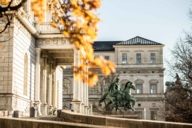
Back when the Schwabing Boheme movement was at its peak in around 1900, it was artists and writers who first began to settle around the university and Art Academy and thus began to shape the spirit of Schwabing.
“Schwabing is not a place, it’s a state of mind.” This is how author and scandalous countess Franziska zu Reventlow described the area 100 years ago. Schwabing stalwarts, like the photographer Wolfgang Roucka, share her view: “Schwabing is not just any old neighbourhood. There are simply no words to describe it. You have to feel it.”
In the streets, cafés, bars and pubs around the university, you will encounter typical neighbourhood figures, including well-known artists like the filmmaker Doris Dörrie and writers Patrick Süskind and Hans Magnus Enzensberger , ( † 24 November 2022) along with some idealists and free thinkers, just like Rainer Langhans, the founder of Kommune 1 and member of the former 68er student movement.
Even back in the early 20th century, it provided a place for artists to live and work, including socio-critical writers like Erich Mühsam, Stefan George and Frank Wedekind and the avant-garde painters from the Blue Rider group.
The painter Paul Klee used to throw wild art parties in the former Schloss Suresnes (Suresnes Palace) on Werneckstrasse, where he had his atelier. A number of other famous names used to live on Ainmillerstrasse, such as the artist couple Gabriele Münter and Wassily Kandinsky, the poet Rainer Maria Rilke, and zoologist Marianne Plehn.
“Schwabing was an island of intellects in the world at large, in Germany and most of all in Munich itself. I lived there for many years. It is where I did my first abstract painting. It is where I really began to think about 'pure' painting and pure art.”
Wassily Kandinsky’s paintings and the world’s largest collection of art by the Blue Rider group are on show in Lenbachhaus art museum. The museum owes it collection to a very generous donation by Gabriele Münter, herself a member of the artists’ group.
Schwabing’s artistic heyday ended with the outbreak of the First World War. During the National Socialist period, groups from the university formed part of the resistance against the Hitler regime.
The Denkstätte Weisse Rose (White Rose Memorial) in the atrium and the memorial on the grounds in front of the main entrance to Ludwig-Maximilians-University pay homage to the student resistance groups who gave their lives for freedom. To pay tribute to Georg Elser, who made a failed attempt to assassinate Hitler in the Bürgerkeller beer hall in 1939, a light installation on Georg-Elser-Platz square is switched on every night at 9:20 p.m.
After sustaining heavy damage during the Second World War, Schwabing is blooming once again. Renovated art nouveau and historicist-style houses stand out amongst the typical 1960s buildings. After the war, the district’s many clubs, music bars and cabaret theatres saw it transform into the hippest part of town and a centre for youth and protest culture.
Theatres like the Münchner Lach- und Schießgesellschaft (a political cabaret theatre founded by Sammy Drechsel and Dieter Hildebrandt in 1956), TamS (Theater am Sozialamt), Heppel & Ettlich, Lustspielhaus and Vereinsheim are still open to this day.
Schwabing has been undergoing something of a revival over the past ten years as a place where young chefs combine the traditional and the modern. For instance, the team from a cocktail bar on Occamstrasse have created “Monaco Vodka”, whose label bears an image of “Monaco Franze”, a character who brought fame to Schwabing in a 1980s TV series.
At the newly renovated Wedekind-Platz square, the “Schwabinger Laterne” has also been restored. This lamppost was the subject of a song by local star Schwabinger Gisela, who performed for years in the pub just across the square. If you love nothing better than to browse through book shops and antique stores, eat in old student pubs and try something unconventional every once in a while (fancy a weisswurst sausage-flavoured ice cream from Amalienstrasse for instance), then Schwabing is the ideal spot.
At Alte Simpl restaurant, you can immerse yourself in the atmosphere of Schwabing in 1900 when the artists and writers who contributed to Simplicissimus magazine met to take a satirical look at the establishment. The paintings and poems that the often penniless artists left behind as payment still hang on the bar’s wood-panelled walls.
Modern design can be experienced in Ingo Maurer's showroom. The internationally renowned lighting designer died in October 2019 at the age of 87. His creations illuminate the whole of Munich: Maurer created the lighting concepts for the Westfriedhof, Münchner Freiheit and Marienplatz underground stations.
Running from north to south right through the middle of Munich you have Leopoldstrasse, a wide poplar-lined boulevard that leads to Siegestor gate and Munich city centre. From one of the countless cafés on this street, you can soak up the peace and quiet while watching the comings and goings of shoppers, cyclists and maybe the odd cabriolet as they make their way up and down Leopoldstrasse. "See and be seen" is another important aspect of Schwabing!
To the east, Leopoldstrasse runs parallel with the Englischer Garten (park) all the way up to the north of Munich. The park is the ideal place to meet students while they are sunbathing between lectures, families enjoying a Sunday picnic, street musicians and amateur footballers. Its most popular destinations are the beer gardens at the Chinesischer Turm (Chinese Tower), Kleinhesseloher See lake, Aumeister and Hirschau.
Become curious? Then revive the former artists' quarter around 1900 with the guided tour "Mythos Schwabing" and let an official guide show you today's Schwabing.